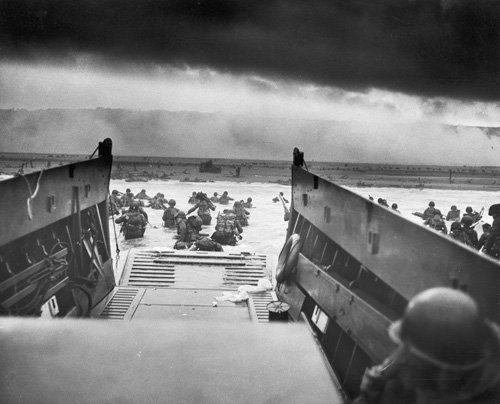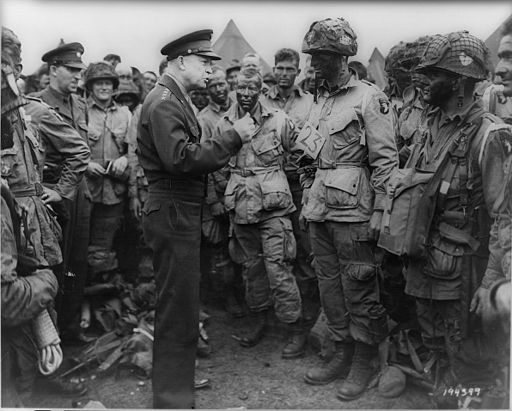"In wartime, truth is so precious that she should always be attended by a bodyguard of lies"
Churchill to Stalin at the Teheran Conference, November 1943

Seventy years ago today, 130,000 American, British and Canadian troops began the largest seaborne assault ever attempted: Operation NEPTUNE, the assault phase of OVERLORD, overall codename for the Allied invasion of occupied north-western Europe.
After months of detailed planning, involving much discussion, a certain amount of friction between Allied military and civilian authorities, and considerable anxiety about everything from German intentions to security arrangements and the weather, the day had finally come.
There had been a false start on 4 June, when bad weather forced ships already embarked to turn back; that night the Supreme Allied Commander, General Dwight D. Eisenhower, was told that if the invasion did not start next day, the weather would cause another 2 weeks’ delay. At dawn on 5 June he gave the order to go ahead, officers on ships opened their sealed orders at 7am, and they set sail.

Though the idea had long been discussed, and Marshal Josef Stalin had been pressing for a ‘Second Front’ in Europe ever since the German invasion of the Soviet Union in June 1941, competing military strategies and tough campaigns in Southern Europe, North Africa, the Middle and Far East delayed a final decision until the Teheran Conference in November 1943. this was the first time when the ‘Big Three’–Stalin, Churchill and Roosevelt – had met in person.
Plans were to be made for an Allied landing in Normandy by the end of May 1944 (OVERLORD), plus an attack in the South of France (ANVIL). Crucial to the success of OVERLORD, which after much hard fighting led to the final defeat of German forces on the European mainland, were a number of intelligence-based operations mounted by Britain and her Allies. Some of these are well known: others have been given less attention. But it is these operations that provide the context to D-Day.
Deception operations
Hitler and his military advisers were expecting an Allied offensive in Europe in 1944. Directive No. 51 of 3 November 1943 stated that ‘Everything indicates that the enemy will launch an offensive against the Western Front of Europe, at the latest in the spring, perhaps even earlier’, and that Hitler had decided to reinforce Western defences, ‘particularly those places from which the long-range bombardment of England will begin’.
Once the Allied decision to launch OVERLORD had been taken at Teheran, instructions were given for a major deception exercise, Operation BODYGUARD, to persuade the enemy to dispose his forces in areas that would least interfere with OVERLORD and ANVIL, and to deceive him as to the strength, timing and objectives of those operations.
An elaborate set of deception plans was implemented, including those designed to indicate a possible Allied attack on Norway (FORTITUDE North) and in the Pas de Calais region (FORTITUDE South), to inflate in the enemy’s mind the strength of Allied forces available for the invasion.
The credibility of these plans was enhanced for the German High Command by intelligence received from double agents like Juan Pujol (GARBO) and Roman Czerniawksi (BRUTUS), who supplied, on MI5’s instructions, reports from imaginary networks of agents.
As D-Day approached, elaborate physical deception plans were set in place, involving dummy aircraft and landing craft, simulated wireless traffic and an entire bogus US Army Group. The cumulative effect was of misdirection and confusion, as intended.
Also crucial to Allied success was the parallel deception plan mounted by the Soviet High Command: Operation BAGRATION, named after a Georgian general in the Napoleonic Wars.
By the spring of 1944 most of the Ukraine and Crimea had been liberated from Axis control, and the Soviet High Command were planning a major attack against the German Army Group Centre, the only significant German force still on Soviet territory, stationed at Minsk in Belorussia.
The Germans expected an attack from the south. BAGRATION, which involved the creation of two entire dummy armies, diversionary earthworks and the stationing of anti-aircraft artillery in the area where the Germans expected to find it, persuaded them that attack would come from the south, and not until the end of the summer.
Nor were they aware that Stalin, who had his eye on a conclusive victory and a swift advance across Eastern Europe, had massively increased the Soviet forces available for the real attack, which began in the north shortly after D-Day.
BAGRATION, together with BODYGUARD and other deception plans, ensured that in May 1944, just before the Allied invasion, the Germans had no idea how many forces they would be facing on either the eastern or western front, where they would attack, or when.
Resistance and special operations
Important contributions to the success of OVERLORD were also made through other clandestine channels, including by Resistance groups and underground intelligence networks in occupied Europe.
Particularly critical to the invasion, as Eisenhower acknowledged, was the disruption of the German V-Weapon programme. This was made possible by the Poles, who provided intelligence on the research facility in Peenemunde, that led to its being bombed in August 1943, delaying though not destroying the rocket programme.
Eisenhower later acknowledged that OVERLORD could have been a ‘washout’ if the V-Weapons had been perfected six months earlier. The Peenemunde raid had a useful side-effect, too. In forcing the Germans to move the testing ground to Blizna in Poland when a complete V2 fell into muddy bushes in May 1944, it was hidden by the Polish Home Army, photographed, dismantled and key parts taken to London by a secret Dakota mission.
Before D-Day special teams were dropped into France to gather intelligence and prepare for the invasion. JEDBURGH teams, each consisting of an American, Englishman and Frenchman, trained in guerrilla tactics and demolition, were dropped in to help and coordinate local French Resistance units. French Special Air Service teams (COONEY) were dropped in to cut rail links with Normandy after the invasion; and 50 two-man Allied intelligence teams (SUSSEX) were dropped into France to transmit intelligence about German movements. All these were part of the massive Allied intelligence operation that backed up D-Day.
Military operations
While all these intelligence-based operations were crucial to D-Day, fighting continued elsewhere in Europe and in the Far East.
The hard-fought Allied campaign in Italy, which led to the fall of Rome two days before D-Day, was important in itself but also tied up German forces that might otherwise have been sent to North-West Europe. In Yugoslavia, Marshal Tito and his People’s Liberation Movement played a significant part in tying up German forces, who mounted a surprise attack on Partisan HQ in May 1944, when Tito was forced to escape to the island of Vis.
The war in the Far East was also at a crucial stage in June 1944, particularly in Burma, New Guinea and the Philippines, though the tide was now turning against the Japanese.
In all these campaigns, intelligence played a key part through the supply of intelligence based on the interception and decryption of enemy traffic: ULTRA, the product of code breaking operations at Bletchley Park and elsewhere. Global conflict is complex, and no single element is decisive. But a large part of the answer to the question ‘What’s the context?’ of D-Day must be the use of secret intelligence and clandestine methods.
- keep tabs on the past: sign up for our email alerts
- follow our Foreign & Commonwealth Historians on Twitter @FCOHistorians
Further reading suggestions:
D-Day and the Battle for Normandy by Antony Beevor (Penguin, 2012)
Russia's War by Richard Overy (Penguin, 2010)
The Double Cross System by J.C. Masterman (Lyons Press, 2000)
Strategic Deception, Vol. 5 of British Intelligence in the Second World War by Michael Howard (Stationery Office Books, July 1990)